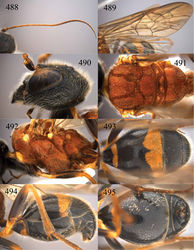Taeniogonalos sculpturata
| Notice: | This page is derived from the original publication listed below, whose author(s) should always be credited. Further contributors may edit and improve the content of this page and, consequently, need to be credited as well (see page history). Any assessment of factual correctness requires a careful review of the original article as well as of subsequent contributions.
If you are uncertain whether your planned contribution is correct or not, we suggest that you use the associated discussion page instead of editing the page directly. This page should be cited as follows (rationale):
Citation formats to copy and paste
BibTeX: @article{Chen2014ZooKeys385, RIS/ Endnote: TY - JOUR Wikipedia/ Citizendium: <ref name="Chen2014ZooKeys385">{{Citation See also the citation download page at the journal. |
Ordo: Hymenoptera
Familia: Trigonalyidae
Genus: Taeniogonalos
Name
Taeniogonalos sculpturata Chen & van Achterberg & He & Xu, 2014 sp. n. – Wikispecies link – ZooBank link – Pensoft Profile
Type material
Holotype, + (SCAU) “[China:] Guizhou, Mt. Fanjing, Huixiangping, 11.VII.1993, Zai-fu Xu, 936625”.
Diagnosis
Supra-antennal elevation 0.4 times as long as scapus and outer side of elevations oblique (Fig. 487) occipital carina widened medio-dorsally and crenulate (Fig. 487); head dorso-posteriorly densely punctate and entirely black (female) (Fig. 487); basal half of antenna (except scapus) yellowish brown (Fig. 488); mesosoma mainly or entirely orange-brown dorsally (Fig. 491) or black with extensive yellowish and orange pattern with middle mesoscutal lobe similar to lateral lobes (Fig. 491); notauli posteriorly and scutellar sulcus wide and both coarsely crenulate (Fig. 491); fore wing without subapical infuscation (Fig. 489); second sternite of female distinctly convex (Fig. 494).
Description
Holotype, female, length of body 12.3 mm (of fore wing 11.1 mm).
Head. Antenna with 26 segments; frons coarsely reticulate-punctate (Fig. 486); vertex coarsely reticulate-punctate behind stemmaticum and near eyes, becoming spaced punctate (interspaces much wider than width of punctures) posteriorly (Fig. 487); temple reticulate-punctate dorsally, becoming spaced punctate ventrally; head gradually narrowed behind eyes, eye in dorsal view 1.2 times as long as temple (Fig. 487); occipital carina widened medio-dorsally and crenulate (Fig. 487); supra-antennal elevations medium-sized (about 0.4 times as long as scapus), outer side oblique and largely smooth except for sparse punctures; clypeus slightly concave and thick medio-ventrally.
Mesosoma. Length of mesosoma 1.4 times its height (Fig. 492); mesopleuron below transverse mesopleural groove transversely rugose anteriorly and smooth posteriorly, above groove entirely transversely rugose (Fig. 492); transverse mesopleural groove rather wide, deep and coarsely crenulate; notauli wide, deep and coarsely crenulate; middle lobe of mesoscutum coarsely reticulate-rugose, lateral lobe mainly rugose; scutellar sulcus wide, both medially and laterally and coarsely crenulate; scutellum coarsely reticulate-rugose, convex medially and anteriorly near level of mesoscutum; metanotum medially slightly convex, not protruding and rugose (Fig. 491); propodeum rugulose to smooth antero-laterally, transversely striate medially, irregularly rugulose posteriorly (Fig. 491); posterior propodeal carina thick lamelliform and slightly arched, foramen medially 0.4 times higher than wide basally.
Wings. Fore wing: length of vein 1-M twice as long as vein 1-SR (Fig. 489).
Metasoma. First tergite 0.6 times as long as apically wide, largely smooth and with distinct elliptical depression medially (Fig. 493); second tergite spaced and rather finely punctate, third–sixth tergites densely and coarsely punctate; first and second sternites spaced and rather finely punctate, third–fifth sternites densely and finely punctate; second sternite distinctly convex, without medio-apical protuberance (Fig. 494); third sternite about 0.1 times as long as second sternite (Fig. 495); hypopygium triangular in ventral view (Fig. 494).
Colour. Head black with pale yellow stripes along inner orbita and apex of supra-antennal elevations and dorsal-medial occipital carina brown; mesosoma orange-brown dorsally (Fig. 491); mesosoma largely orange-brown laterally except for anterior and dorsal yellow patches of pronotal side and dark brown propleuron; metasoma with moderately wide orange-yellow apical band at apex of first tergite and sternite, second tergite with broad orange-yellow band at posterior margin, remainder of metasoma black; palpi dark brown; mandible black with teeth dark brown; basal half of antenna (except scapus) yellowish brown, scapus and apical half of antenna dark brown (Fig. 488); trochanters and trochantelli and base of femora of all legs pale yellow, tibiae and tarsi of fore and mid leg yellowish brown, mid and hind coxae orange-brown, remainder of legs dark brown; pterostigma dark brown, remainder of wing membrane subhyaline.
Male. Unknown.
Biology
Unknown. Collected in July.
Distribution
China (Guizhou).
Etymology
Named after the coarsely sculptured notauli and scutellar sulcus: from “sculpturatus” (Latin for “sculptured”).
Original Description
- Chen, H; van Achterberg, C; He, J; Xu, Z; 2014: A revision of the Chinese Trigonalyidae (Hymenoptera, Trigonalyoidea) ZooKeys, 385: 1-207. doi
Images
|

